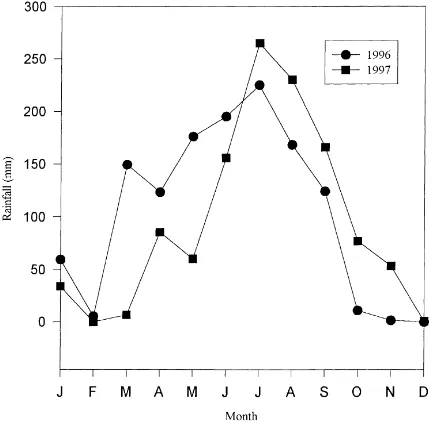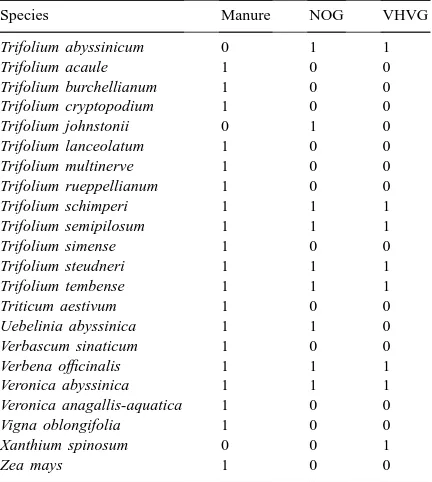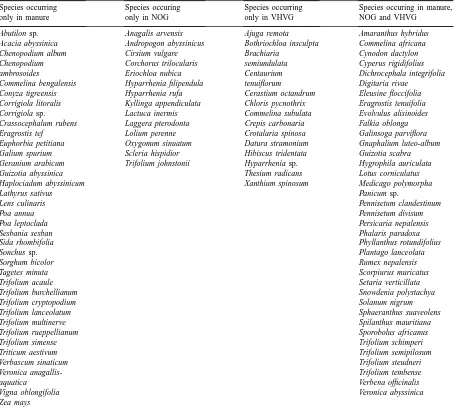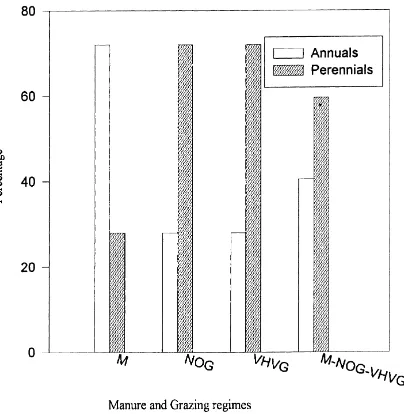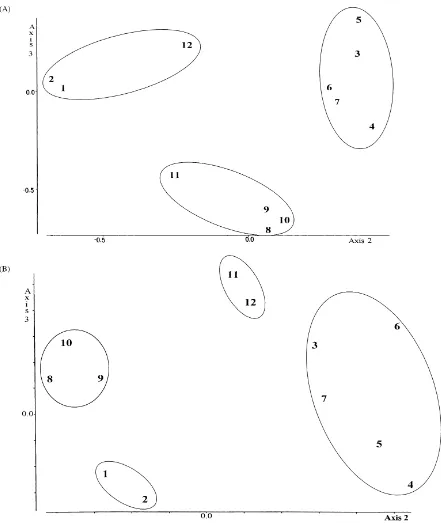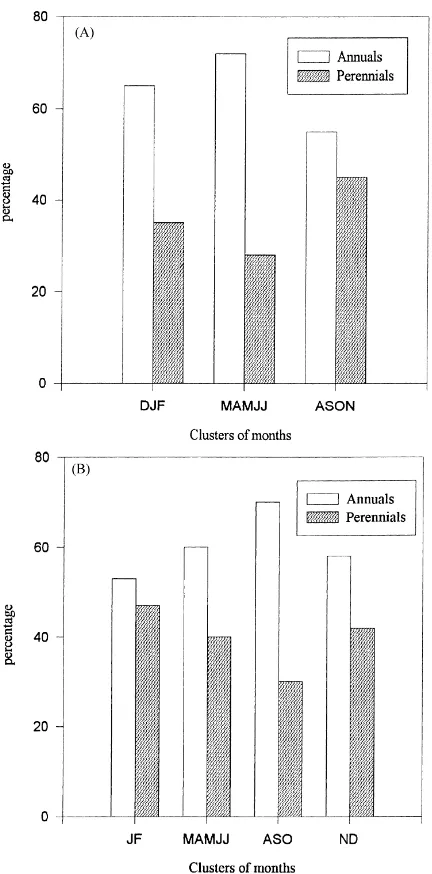Grazing induced biodiversity in the highland ecozone of East Africa
Zerihun Woldu
a, M.A. Mohammed Saleem
b,∗aDepartment of Biology, the National Herbarium, Addis Ababa University, P.O.Box 3434, Addis Ababa, Ethiopia bInternational Livestock Research Institute (ILRI), P.O.Box 5689, Addis Ababa, Ethiopia
Received 15 April 1999; received in revised form 11 August 1999; accepted 22 October 1999
Abstract
The species composition of grazing lands can be influenced by livestock and grazing pressure. A study on manure seed bank was conducted in Ghinchi highland Research Site in Ethiopia between 1995 and 1997. The data on species composition and life-form of the plants germinating in pots receiving air dried manure were compared with species composition of experimental plots in natural grassland subjected to varying grazing intensity. There was significant difference among the species composition of grazed and non-grazed grasslands and the manure seed bank (p=0.01). The life-forms of the species also showed variation. There were more families and species in the natural grassland vegetation than indicated in the manure seed bank. The manure seed bank had more annuals than the natural grassland vegetation. The species composition and life-forms in the manure seed bank showed variation with time and this corresponded with the seasonal variation in the grassland, which had a direct relationship with the rainfall pattern. The study showed that livestock play a major role in maintaining the biodiversity of grassland vegetation by spatial and temporal dispersion of readily germinating seeds in their manure. The use of manure to improve soil fertility should be weighed cautiously against the introduction of weeds into crop fields, although weeds are important feed resource for livestock in land-constrained areas. There is therefore the need for developing manure management practices so that the benefits can be optimised and the undesirable effects can be minimised. © 2000 Elsevier Science B.V. All rights reserved.
Keywords: Manure; Species; Life-form; Livestock; Seed bank; Biodiversity
1. Introduction
A long history of land clearing and sedentary agri-culture has changed the vegetation cover in the east African highlands. The natural vegetation of the cen-tral plateau of Ethiopia, for example, may have been dry evergreen montane forest with Juniperus procera and Olea europaea sp. cuspidata as the dominant species (Pichi Sermoli, 1957). This vegetation type
∗Corresponding author. Tel.:+251-1-613215; fax:+251-1-611892.
E-mail address: [email protected] (M.A. Mohammed Saleem)
has disappeared from most parts of the highland ex-cept in few remnant patches around holy places and inaccessible areas. Records of early travelers in the fifteenth and sixteenth century (Almeida, 1954; Al-varez, 1970) indicate that the agro-climate conditions of the Ethiopian highland about 500 years ago were similar to the present day conditions except that the density of trees then was higher in the crop fields.
The central plateau of Ethiopia is characterised by mixed cereal and livestock agriculture. Nutrient deficient soils, high stocking rates and shortage of animal feeds are common features. Livestock in the highlands account for 80% of the total population and
about 20% of the agricultural gross domestic product of the country (Mengistu, 1997). The livestock are herded together and grazed on communal pastures, private land and stables depending on the time and season of the year. Cattle are the most important live-stock species in the Ethiopian agriculture and they are kept mainly for traction and milk production. Grazing is being expanded to very steep slopes and marginal lands, as more land is cultivated to compen-sate for the diminishing soil fertility and to meet the ever-increasing food demands.
The species composition and productivity of the pasture of the common grazing lands are highly influ-enced by the species of the livestock, the intensity of grazing, climatic and edaphic factors. The seasonal stocking rate on the central plateau of Ethiopia is very high for the ecological carrying capacity of the grassland (Woldu, 1986). The grassland communities are predominantly of Pennisetum sphacelatum– Commelina africana type and could develop to Andro-pogon abyssinicus–Hyparrhenia arrhenobasis type if grazing intensity is relaxed (Woldu, 1986).
Grasslands in general are stressful environments. Defoliation, uprooting, trampling and desiccation are the important stresses in grasslands under high graz-ing pressure. The role of livestock on the grassland vegetation can be seen from two main perspectives. The most obvious one is the influence on the species composition and reduction in the above and below ground biomass. The less obvious but equally im-portant is the maintenance and distribution of the biodiversity. Free grazing livestock move to any ac-cessible site and their feeding behaviour or foraging choice may generate a pattern of association between the plant species and the livestock. This relationship helps in seed dispersal which may be manifested in spatial and temporal differences in ground cover and patchiness. Seed morphology may influence whether seeds survive the mastication and the digestive en-zymes of the ingesting animal. Those that survive through the animal gut germinate faster as dormancy is broken by the abrasion, scarification and wetting of the digestive system of the animal. On the other hand, seeds retained in the animal gut for a long period may be induced to germinate and be killed while in the gut (Janzen, 1982a, b). Deposition of seeds with manure gives a better chance of survival since a source of ni-trogen is readily available for early seedling growth. It
appears, therefore, that the animal gut filters out those species by enhancing their germination while in the gut and by providing favourable conditions when they are released. It is with this understanding that an ex-periment was designed to study the species composi-tion of manure seed bank at different times of the year and compare these with the species composition of natural grasslands under different grazing pressures.
The specific objectives of this study were (1) to de-termine the species composition and richness of germi-nating seeds in manure seed bank, (2) to compare the species composition of manure seed bank and those of the natural grassland under different grazing pressure, (3) to assess the role of livestock in the maintenance of the biodiversity of the grassland vegetation through the spatial transfer of seeds in their manure, and (4) to assess the use of manure in improving soil fertility.
2. Materials and methods
2.1. Experimental site
Two complementing experiments were conducted at Ghinchi Research Station, a local research base, where the International Livestock Research Institute (ILRI) is working with a consortium of institutions on natural resource management issues. Ghinchi is located in the Ethiopian highlands at 2290 m asl 80 km west of Addis Ababa (9◦02′N; 38◦07′E). The experiments include
manure seed bank pot trials and grazing experiments in six different sites.
2.2. Manure seed bank pot trials
was run for two complete years, August 1996–July 1997 and August 1997–July 1998. The plant species and other data for each replicate of the week were entered in access database. Relevant information was extracted using the structured query language.
2.3. Grazing experiments
To study the influence of grazing on the grass-land vegetation, six sites with varying slopes ranging from 0–8% were selected to represent the area where the livestock of the community grazed. Each site had 10 m×10 m plots where (a) grazing was totally pre-cluded (NOG), (b) moderately grazed (MDG — 1.8 Tropical Livestock Unit Month — TLUM/ha) and (c) very heavily grazed (VHVG — 4.2 TLUM/ha) (see also Mwendera et al., 1997). The NOG and MDG plots were enclosed by barbed wire fences and there was no fencing around VHVG plots. The door of the fence around MDG was opened for 3 days in a week for the free grazing livestock of the farming commu-nity. Grazing took place during all days of the week in VHVG. Data on species composition, per cent cover of three most dominant species and bare ground were collected at 30 days interval from the second week of September to the second week of December. This pe-riod is shortly after the summer rain season when plant growth rate is maximal and most plants bear inflo-rescence. During the long dry period (January–May) and the summer rain period (June–September) most species in VHVG and some in MDG and NOG are not identifiable. Data were collected for three consecutive years from 1995–1997.
Only the list of species in NOG and VHVG were considered for the present article. The result which includes MDG will be communicated in another pub-lication.
2.4. Data analysis
The weekly manure-seedling data from the five replicates were pooled for each month and a data matrix was constructed for each year with the species in the rows and months on the columns. The species composition of the manure (M) was compared with data on the grazing experiment plots using chi square (χ2). The relative occurrences of the four important grassland families were calculated for each year of
Fig. 1. Monthly average rainfall in Ghinchi Research Station, Ethiopia in 1996 and 1997.
the grazing experiment and manure seed bank data. The relative composition of the annual and peren-nial species in each experiment was also calculated. Rainfall data of 1996 and 1997 was obtained from Ethiopian Agricultural Research Meteorological Ser-vices and the monthly average rainfall of the 2 years were plotted (Fig. 1).
Principal Components Analysis (PCA) was per-formed using Syntax to find the influence of time on the species composition of the manure seed bank. The PCA is an ordination technique which involves extracting the same number of axes of variations as in the rows or columns of the input data matrix in decreasing order of importance. Scatter diagram (scattergram) of the two axes showing the highest variations provides a two dimensional display of the underlying pattern in the original data matrix (see Orloci, 1978).
3. Results and discussion
3.1. Species in manure seed bank and grazing experiment
Table 1
List of species in manure seed bank (M), no grazing plots (NOG) and very heavily grazed (VHVG)a
Species Manure NOG VHVG
Abutilon sp. 1 0 0
Acacia abyssinica 1 0 0
Ajuga remota 0 0 1
Alchemilla fischeri 0 1 1
Amaranthus hybridus 1 1 1
Anagalis arvensis 0 1 0
Andropogon abyssinicus 0 1 0
Arthraxon lancifolius 1 1 0
Bidens biternata 0 1 1
Bidens pilosa 0 1 1
Bothriochloa insculpta 0 0 1
Brachiaria semiundulata 0 0 1
Brassica nepus 1 0 1
Carduus chamaecephalus 0 1 1
Carum carvi 1 1 0
Centaurium tenuiflorum 0 0 1
Cerastium octandrum 0 0 1
Chenopodium album 1 0 0
Chenopodium ambrosoides 1 0 0
Chloris pycnothrix 0 0 1
Cineraria abyssinica 0 1 1
Cirsium vulgare 0 1 0
Coleus punctatus 0 1 1
Commelina africana 1 1 1
Commelina bengalensis 1 0 0
Commelina subulata 0 0 1
Conyza tigreensis 1 0 0
Corchorus trilocularis 0 1 0
Corrigiola litoralis 1 0 0
Corrigiola sp. 1 0 0
Crassocephalum rubens 1 0 0
Crepis carbonaria 0 0 1
Crotalaria spinosa 0 0 1
Cynodon dactylon 1 1 1
Cynoglossum coeruleum 1 0 1
Cyperus rigidifolius 1 1 1
Cyperus teneriffae 1 0 1
Datura stramonium 0 0 1
Dichrocephala integrifolia 1 1 1
Digitaria rivae 1 1 1
Dischoriste radicans 0 1 1
Echinochloa colona 0 1 1
Eleusine floccifolia 1 1 1
Eragrostis botryodes 0 1 1
Eragrostis tef 1 0 0
Eragrostis tenuifolia 1 1 1
Eriochloa meyeriana 0 1 0
Euphorbia petitiana 1 0 0
Evolvulus alisinoides 1 1 1
Falkia oblonga 1 1 1
Fimbristylis complanata 0 1 1
Galinsoga parviflora 1 1 1
Galium spurium 1 0 0
Table 1 (Continued).
Species Manure NOG VHVG
Geranium arabicum 1 0 0
Gnaphalium luteo-album 1 1 1
Guizotia abyssinica 1 0 0
Guizotia scabra 1 1 1
Haplociadum abyssinicum 1 0 0
Hibiscus sp. 0 1 1
Hibiscus tridentata 0 0 1
Hibiscus trionum 0 1 1
Hygrophila auriculata 1 1 1
Hyparrhenia arrhenobasis 0 1 1
Hyparrhenia filipendula 0 1 0
Hyparrhenia hirta 0 1 1
Hyparrhenia rufa 0 1 0
Hyparrhenia sp. 0 0 1
Indigofera sp. 0 1 1
Kohautia coccinia 0 1 1
Kyllinga appendiculata 0 1 0
Lactuca inermis 0 1 0
Laggera pterodonta 0 1 0
Lathyrus sativus 1 0 0
Lens culinaris 1 0 0
Leucas marticinensis 0 1 1
Lolium perenne 0 1 0
Lotus corniculatus 1 1 1
Medicago polymorpha 1 1 1
Oxygonum sinuatum 0 1 0
Panicum sp. 1 1 1
Pennisetum clandestinum 1 1 1
Pennisetum divisum 1 1 1
Pennisetum riparium 0 1 1
Pennisetum villosum 1 0 1
Persicaria nepalensis 1 1 1
Phalaris paradoxa 1 1 1
Phyllanthus rotundifolius 1 1 1
Plantago lanceolata 1 1 1
Poa annua 1 0 0
Poa leptoclada 1 0 0
Polygala sp. 0 1 1
Rumex nepalensis 1 1 1
Scirpus inclinatus 0 1 1
Scleria clathrata 0 1 1
Scleria hispidior 0 1 0
Scorpiurus muricatus 1 1 1
Sesbania sesban 1 0 0
Setaria verticillata 1 1 1
Sida rhombifolia 1 0 0
Snowdenia polystachya 1 1 1
Solanum nigrum 1 1 1
Sonchus sp. 1 0 0
Sorghum bicolor 1 0 0
Sphaeranthus suaveolens 1 1 1
Spilanthus mauritiana 1 1 1
Sporobolus africanus 1 1 1
Tagetes minuta 1 0 0
Table 1 (Continued).
Species Manure NOG VHVG
Trifolium abyssinicum 0 1 1
Trifolium acaule 1 0 0
Trifolium burchellianum 1 0 0
Trifolium cryptopodium 1 0 0
Trifolium johnstonii 0 1 0
Trifolium lanceolatum 1 0 0
Trifolium multinerve 1 0 0
Trifolium rueppellianum 1 0 0
Trifolium schimperi 1 1 1
Trifolium semipilosum 1 1 1
Trifolium simense 1 0 0
Trifolium steudneri 1 1 1
Trifolium tembense 1 1 1
Triticum aestivum 1 0 0
Uebelinia abyssinica 1 1 0
Verbascum sinaticum 1 0 0
Verbena officinalis 1 1 1
Veronica abyssinica 1 1 1
Veronica anagallis-aquatica 1 0 0
Vigna oblongifolia 1 0 0
Xanthium spinosum 0 0 1
Zea mays 1 0 0
a0 stands for absence and 1 stands for presence.
1996 and 1997, and the occurrence of species in the NOG and VHVG from 1995 to 1997.
The number of species per year in the grazing ex-periment ranged between 50 and 59 while it ranged between 62 and 64 in the manure experiment (Table 2). The number of families in the grazing areas ranged between 16 and 21 while it ranged between 17 and 22 in the manure experiment when the data of each year
Table 2
Proportion of the four important plant families in the grazing area and in the manure during the study period at Ghinchi in the Ethiopian highlands over 3 years
Grazing areas Manure
1995 1996 1997 6 1996 1997 6
Species 50 59 50 94 62 64 86
Families 16 21 17 28 18 22 24
1 Poaceae (32%) Poaceae (24%) Poaceae (34%) Fabaceae (26%) Poaceae (23%) 2 Fabaceae (14%) Asteraceae (20%) Asteraceae (20%) Poaceae (23%) Fabaceae (20%) 3 Asteraceae (12%) Fabaceae (11%) Fabaceae (8%) Asteraceae (13%) Asteraceae (13%) 4 Cyperaceae (12%) Cyperaceae (10%) Cyperaceae (6%) Cyperaceae (5%) Cyperaceae (5%)
Total 70% 65% 66% 67% 61%
are considered separately. The number of species creased to 94 and 79; and the number of families in-creased to 28 and 24 in the grazing areas and manure seed bank, respectively, when the data of the whole period were pooled together. The grazing experiments and the manure seed bank had 37 species (14 families) in common. The manure seed bank species included six annual food crop species.
The relative importance of the four major grass-land families in Ghinchi grazing area corresponded to the pattern in the grassland communities in the east African highlands in general, and in Ethiopia, in par-ticular (Woldu, 1986). Members of the Poaceae were the highest, followed by those of Asteraceae, Fabaceae and Cyperaceae in that order. In the manure seed bank, however, Poaceae and Fabaceae were equal in impor-tance and were higher than the other two families. The percentage of Asteraceae was higher and the percent-age of Cyperaceae was lower than in the grassland communities. The number of species, families and the relative importance are presented in Table 2.
Table 3
Species unique to manure seed bank (M), no grazing (NOG), very heavily grazed (VHVG) and those common to the three treatments (M–NOG–VHVG)
Species occurring Species occuring Species occurring Species occuring in manure,
only in manure only in NOG only in VHVG NOG and VHVG
Abutilon sp. Anagalis arvensis Ajuga remota Amaranthus hybridus Acacia abyssinica Andropogon abyssinicus Bothriochloa insculpta Commelina africana Chenopodium album Cirsium vulgare Brachiaria Cynodon dactylon Chenopodium Corchorus trilocularis semiundulata Cyperus rigidifolius ambrosoides Eriochloa nubica Centaurium Dichrocephala integrifolia Commelina bengalensis Hyparrhenia filipendula tenuiflorum Digitaria rivae
Conyza tigreensis Hyparrhenia rufa Cerastium octandrum Eleusine floccifolia Corrigiola litoralis Kyllinga appendiculata Chloris pycnothrix Eragrostis tenuifolia Corrigiola sp. Lactuca inermis Commelina subulata Evolvulus alisinoides Crassocephalum rubens Laggera pterodonta Crepis carbonaria Falkia oblonga Eragrostis tef Lolium perenne Crotalaria spinosa Galinsoga parviflora Euphorbia petitiana Oxygonum sinuatum Datura stramonium Gnaphalium luteo-album Galium spurium Scleria hispidior Hibiscus tridentata Guizotia scabra Geranium arabicum Trifolium johnstonii Hyparrhenia sp. Hygrophila auriculata Guizotia abyssinica Thesium radicans Lotus corniculatus Haplociadum abyssinicum Xanthium spinosum Medicago polymorpha
Lathyrus sativus Panicum sp.
Lens culinaris Pennisetum clandestinum
Poa annua Pennisetum divisum
Poa leptoclada Persicaria nepalensis
Sesbania sesban Phalaris paradoxa
Sida rhombifolia Phyllanthus rotundifolius
Sonchus sp. Plantago lanceolata
Sorghum bicolor Rumex nepalensis
Tagetes minuta Scorpiurus muricatus
Trifolium acaule Setaria verticillata
Trifolium burchellianum Snowdenia polystachya
Trifolium cryptopodium Solanum nigrum
Trifolium lanceolatum Sphaeranthus suaveolens
Trifolium multinerve Spilanthus mauritiana
Trifolium rueppellianum Sporobolus africanus
Trifolium simense Trifolium schimperi
Triticum aestivum Trifolium semipilosum
Verbascum sinaticum Trifolium steudneri
Veronica anagallis- Trifolium tembense
aquatica Verbena officinalis
Vigna oblongifolia Veronica abyssinica
Zea mays
3.2. Proportion of life-forms
The pattern of occurrence of annuals and perennials in M clearly follows the pattern of the rainfall (Figs. 1, 2A and B). Although the Ethiopian highland is known for its bimodal rainfall (Gamachu, 1977), the rainfall pattern of Ghinchi in 1996 and 1997 was unimodal. Comparison of the rainfall of the 1996 and 1997 shows that the rainfall in 1996 was evenly distributed while
Fig. 2. Annuals and perennials in the species composition of the manure seed bank in (A) 1996; (B) 1997.
but encouraged the persistence of perennials through out the year. The composition of annuals in M was 63%, while that of the grassland (NOG, and VHVG pooled together) was 41%. Seventy eight percent of the species unique to M were annuals, while the pro-portions of annuals unique to NOG and VHVG were 28% only. The proportion of annuals in the species
Fig. 3. Proportion of annuals and perennials in the species unique to manure seed bank (M), no grazing (NOG), very heav-ily grazed (VHVG) and those common to the three treatments (M–NOG–VHVG)
common to M, NOG and VHVG was 40.5% (Fig. 3). The list of species is given in Table 3.
3.3. Temporal patterns of occurrence
The seasonal pattern in the samples indicates that the seeds of perennials attain dominance at the peak of the rainfall (July–September) while the seeds of the annuals were dominant during the rest of the year.
Fig. 5. Annuals and perennials in the ordination cluster of (A) 1996; (B) 1997. The letters in the scattergram correspond to months.
grazing areas matured at different times of the year and therefore had diverse phenological history.
4. Implications
Landscapes are made up of mosaics of different habitats arranged in intricate patterns at different
scales and formed through ecological and cultural processes (Harris, 1984; Forman and Gordon, 1986). This study has shown that the influence of livestock on landscape is expressed through their effect on vegetation. This effect is expressed through the elim-ination of some species and the dominance of others with a decrease in ground cover and diversity of palat-able species. The influence of livestock on botanical composition and species richness depended on stock-ing rate (see also Mwenedera et al., 1997). Livestock in free grazing systems has a very important but less perceived influence on vegetation as agents of seed dispersal.
5. Conclusions
This research has made it possible to obtain the temporal variations within the manure seed bank and comparison of the data with those of the natural grassland. The role of livestock in grasslands may be viewed as important agents in maintaining landscape and species diversity and this can be realized if efforts are made to keep the stocking rate within the limits of the carrying capacity of the grazing areas. Further study on carrying capacity of the natural grasslands, improved methods of producing more livestock feed and detailed experiments on some important species in manure seed bank will complement the findings in this research.
References
Almeida, M.D., 1954. Some Records of Ethiopia 1593–1664 — C.P. Bekingham and C.W.B. (Huntingford translation and edition). The University Press, Glasgow.
Alvarez, F., 1970. Portuguese Embassy to Abyssinia during the years 1520–1527 — Lord Stanley of Adlerley (translation and edition). Burt Franklin Publisher, NY.
Forman, R.T., Gordon, M., 1986. Landscape Ecology. Wiley, NY, Chichester, Brisbone, Toronto, Singapore.
Gamachu, D., 1977. Aspects of climate and water budget in Ethiopia. Addis Ababa University Press, Addis Ababa. Harris, L.D., 1984. Habitat fragmentation. In: Meffe, K.G., Carrol,
C.R. et al. (Eds.), Principles of Conservastion Biology. Sinauer Associates, Inc., Saunderland, MA, pp. 237–258.
Janzen, D.H., 1982a. Differential seed survival and passage rates in cows and horses, surrogate pleistocene dispersal agents. Oikos 38, 150–156.
Janzen, D.H., 1982b. Removal of seeds from tropical rodents: influence of habitat and amount of dung. Ecology 63, 1887– 1900.
Mengistu A., 1997. Conservation Based Forage Development for Ethiopia. Self Help Development International Institute for sustainable Development, Addis Ababa, Ethiopia.
Mwendera, E.J., Mohame Saleem, M.A., Zerihun, W., 1997. Vegetation response to cattle grazing in the Ethiopian highlands. Agric. Ecosystem Environ. 64, 43–51.
Orloci, L., 1978. Multivariate Analysis in Vegetation Research, 2nd Edition. Junk, The Hague.
Pichi Sermoli, R.C.E., 1957. Una carta geobotanica dell’ Africa Orientale, Etiopia, Eritrea ed Somalia. Webbia 13, 15–132. Stroud, A., Parker, C., 1989. A weed identification guide for
Ethiopia. TCP/ETH/4532, Food and Agricultural Organization of the United Nations, Rome.
